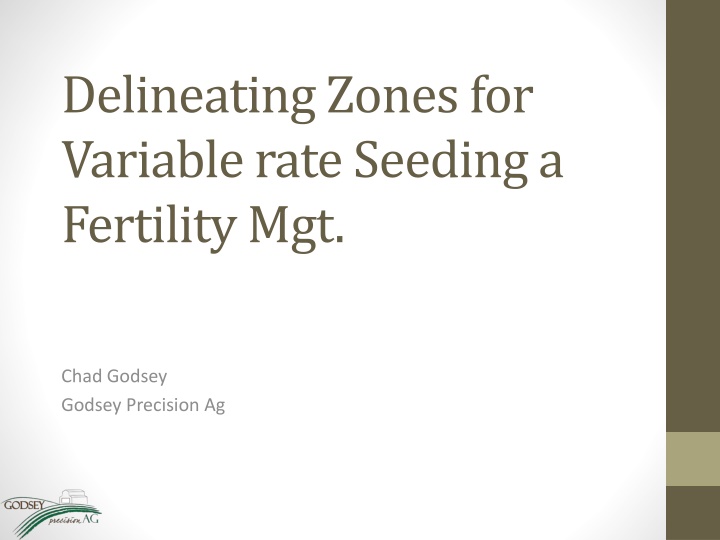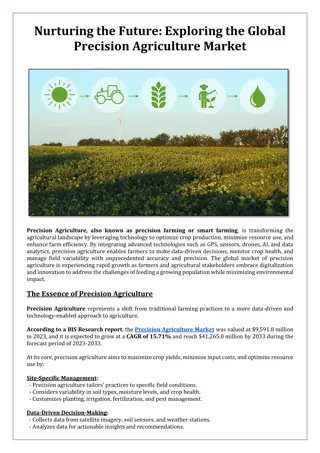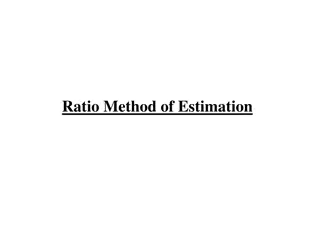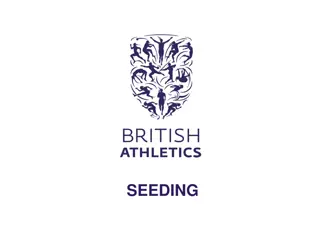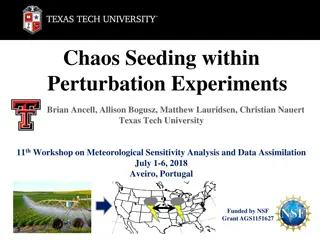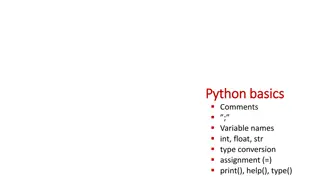Precision Agriculture Techniques for Variable Rate Seeding
Precision agriculture practices, led by experts like Chad Godsey, focus on tailored approaches for variable rate seeding. The philosophy emphasizes individualized planning and continuous dialogue with producers. Utilizing yield data and prescriptions, decision-making is based on various factors like yield history and on-farm research, leading to optimized management zones. Multi-year yield analysis, incorporating data into decisions, and creating management zones are key strategies for enhancing yields and reducing input costs.
Download Presentation

Please find below an Image/Link to download the presentation.
The content on the website is provided AS IS for your information and personal use only. It may not be sold, licensed, or shared on other websites without obtaining consent from the author.If you encounter any issues during the download, it is possible that the publisher has removed the file from their server.
You are allowed to download the files provided on this website for personal or commercial use, subject to the condition that they are used lawfully. All files are the property of their respective owners.
The content on the website is provided AS IS for your information and personal use only. It may not be sold, licensed, or shared on other websites without obtaining consent from the author.
E N D
Presentation Transcript
Delineating Zones for Variable rate Seeding a Fertility Mgt. Chad Godsey Godsey Precision Ag
Philosophy Every producer is at a different point in adoption so cookie cutter approaches do not work in lot of cases. Each plan has to be made individually to accomplish goals. Development of precision ag technologies like prescriptions should be a continuous dialogue between producers and myself until prescriptions are final.
Basis for Decision Making -Prescriptions Best case scenario-several years of yield data Elevation Soils Maps Producers knowledge EC/EM data
Collecting Yield Data Yield monitor data serves two main purposes: 1. Enables evaluation of current year s management 2. Provides data for future years in regards to how management could be altered to increase yields and/or decrease input costs. Advantages: Build a history of yield data to identify management zones Identify problems that occurred during the current growing season that resulting in yield loss or gain Evaluating on-farm research trials
Use of Yield Data The most powerful use of yield data is when multiple years of data are combined in order to determine management practices that will increase yields or decrease input costs. There is no better method in delineating management zones than through using yield data history. Multiple year yield analysis will define areas that are consistently high, medium, or low averaging.
Yield History Multi-year yield analysis Implement variable rate technologies End of Year Analysis Incorporate data into next year s decisions
Figure 1. Three years of yield history with basic uniform management. Yields lowest to highest are brown, yellow, light green, dark green, and blue.
Multi-year Yield Map Analysis Relative grain yield Year to year stability Management Zones for seeding Figure on the left is relative or normalized grain yield over a 4 year period. Yellow area is 95 -105% of the field average for the time period. The middle figure is a measure of the yield stability from year to year. The lightest purple area is very stable. The figure on the right is using the information in the first two figures to generate management zones.
Variable Rate Seeding The ideal seeding rate no doubt changes within a field for most fields in the Southern Plains. Several methods can be used like elevation and soil map but yield history is by far the best.
Seeding 70 60 50 Yield (bu/ac) 40 90,000 30 125,000 20 140,000 10 0 1 3 5 7 9 11 13 15 17 19 21 Grid ID (West to East)
Variable Rate Seeding Typically, save $1-5/acre in seed. Producers typically have a good idea of what population works best where. Match hybrid with population Biggest upside is increase in yield in low yielding area of the field.
Example Step 1 2.5 acre grid sample Step 2 Multi-year yield analysis Step 3 Variable Rate Seeding Step 4 Variable rate N side-dress application Step 5 End of year analysis
Nitrogen Management Based on historic yield potential Best if utilized with side- dressing Possibility of variably applying pre-plant depending on what operations are conducted pre- plant
Nitrogen Managment Example Basic Program 40 lb N/ac as starter Side-dress: vary rates 15 to 100 lb N/ac Sprinkler: 100 lb N/ac Figure 0.8 to 0.9 lb N/bushel of corn Averaged close to $10/ac savings in N fertilizer Savings comes from low yielding areas Yield upside is in high yielding areas of the field
Summary Like I said before, everybody is at a different place in adoption and most individuals have different management strategies. Develop clear goals and improve and increase use of technology each year.
Thank You Chad Godsey Phone: 970-630-7732 Email: chad.godsey@godseyag.com Fax: 405-896-8420 Web: godseyag.com Twitter: @godseyag
